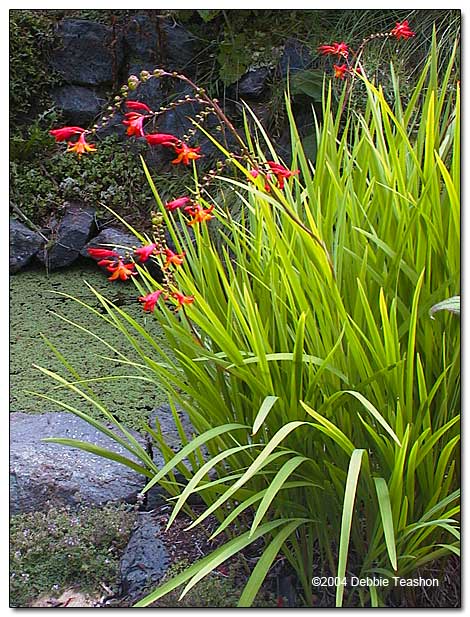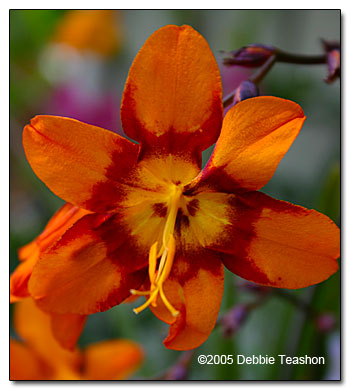Crocosmia Cultivars
syn. Antholyza, Curtonus, Montbretia
Family: Iridaceae
Pronounced: kro-KOS-mee-a
Click on thumbnails at the bottom of the page to see individual cultivars of crocosmias and their indiviidual attributes and zones where they are hardy.
Quick Jumps
Growing Guide
Rainy Side Notes
GROWING GUIDE

Plant Group:
Bulbs.
Flowering period:
Most crocosmias begin blooming in July.
Leaf attributes:
Most leaves are long, linear and narrow, 1-2 inches wide (3-5 cm), by 24-28 inches long (60-70 cm). Most leaves bend over, giving the plants a fountain like shape.
Light:
Full sun to light shade.
Soil:
Humus rich, moist, well-drained soil.
Feeding:
Fertilize at planting time and in the spring, with a complete organic fertilizer.
Propagation Methods:
Division.
Rainy Side Notes

When I look at a Crocosmias, I think of tropical plants. They are bold and beautiful with a touch of the exotic. I am taken back to when I lived in Hawaii. I can visualize a crocosmia looking right at home next to a Bird of Paradise shrub or under a coconut tree.

Crocosmias x crocosmiiflora is a cross between C. aurea and C. pottsii. Hybrids of this beautiful cross include the ever-popular C. 'Lucifer' and many other cultivars of merit. Crocosmia comes from the Greek words, krokos (saffron) and osme (smell), because the dried flowers, when immersed in warm water, smell like saffron.
Plant corms to a depth of one to two inches (3-5 cm) and no deeper. In our maritime climate, we do not need to lift corms in winter since the plants are hardy. In most areas colder than USDA zone 6, it will be essential; however, some cultivars may prove to be perennial in protected zone five areas. Approximately every three to four years, divide clumps when flower production is less vigorous. Crocosmia can be mildly invasive so site away from smaller plants. Crocosmias are attractive to hummingbirds.
Crocosmias are excellent as fresh or dry cut flowers, and seed heads dry nicely for dried arrangements. Harvest fresh flowers when the first few buds show color. Handle the flowers with care, as they are delicate. Vase life is approximately seven to ten days. Keep the flower vases away from fruit, because fruit gasses will ruin the harvest. Dry flowers in bunches, upside down in a warm, dry area. Harvest seed pods before they open in the fall, and bundle ten per bunch. For grass-like additions to dried arrangements, dry the leaves with plenty of air circulation so the foliage retains its color.
Click on thumbnails below to view each cultivar of Crocosmias with attributes listed for each one.

'Emily McKenzie'

'George Davison'

'Kathleen'

'Solfatare'

Gardening for the Homebrewer: Grow and Process Plants for Making Beer, Wine, Gruit, Cider, Perry, and More
By co-authors Debbie Teashon (Rainy Side Gardeners) and Wendy Tweton
Copyright Notice | Home | Search | Perennials

